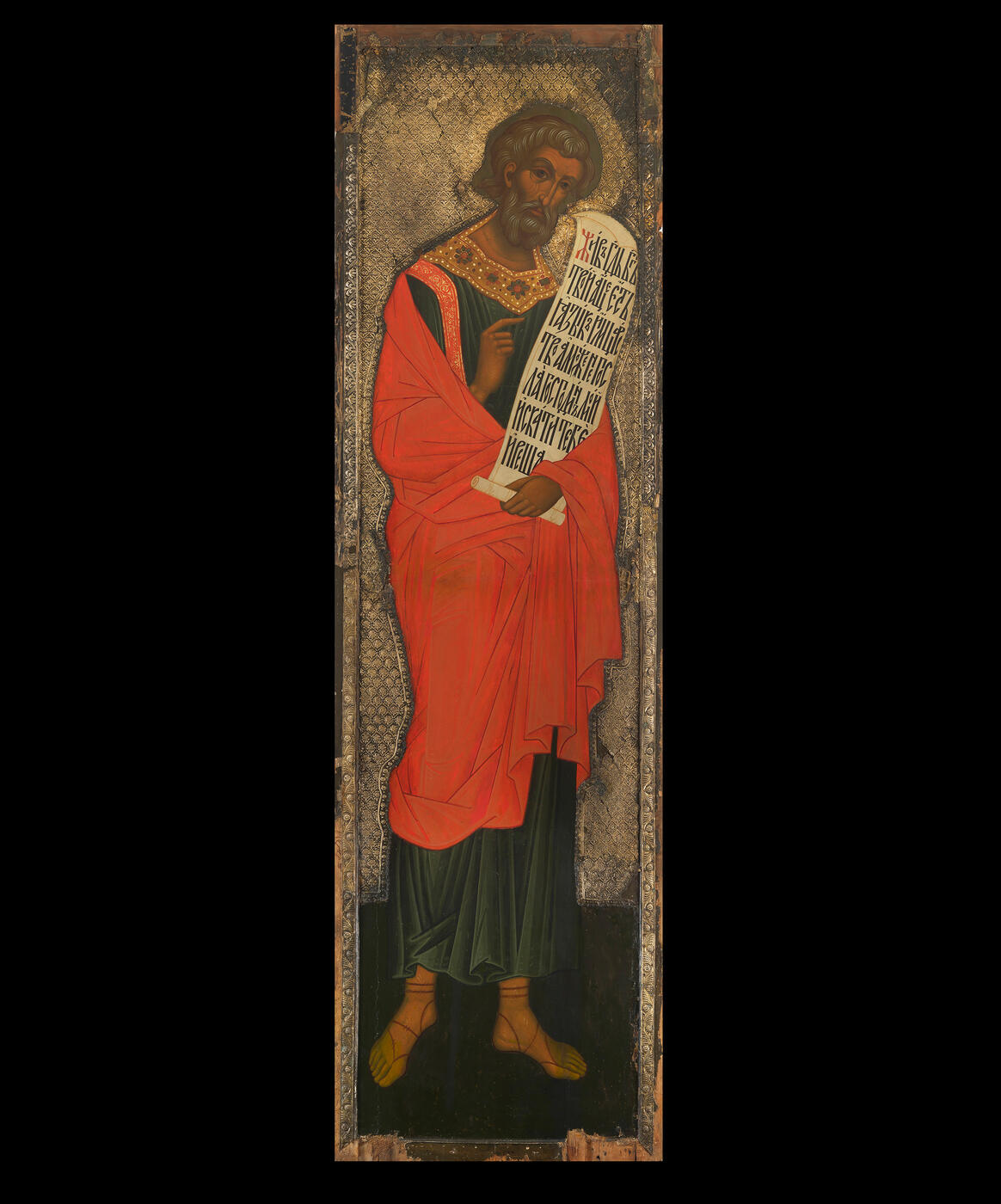25 - 28 November 2012 Russian Art Auctions
25 November 2012

* 505. A LARGE ICON OF THE PROPHET OBADIAH
N. EMELYANOV, 1912, BASMA POSSIBLY BY OLOVYANISHNIKOV & SONS MANUFACTORY, ICON FROM THE PROPHET ROW OF THE ICONOSTASIS OF THE FEODOROVSKY CATHEDRAL, TSARSKOYE SELO .
218.5 by 63 cm.
35,000–50,000 GBP
Related literature: For Emelyanov work, see Feodorovsky Gosudarev Sobor v Tsarskom Sele. Vypusk 1: Pescherniy Hram vo Imya Prepodobnogo Serafima Sarovskogo Chudotvortsa (Feodorovsky Sovereign Cathedral in Tsarskoye Selo. Issue 1: Cave Church of St Seraphim of Sarov the Miracle-Worker), Feodorovskiy Sovereign Cathedral, Petersburg, 1914, p. 18, 23.
V.M. Vasnetsov and D.N. Loman (based on letters and documents from Russian State Historical Archive), Moskva v Nachale XX Veka (Moscow in the Early 20th Century), Moscow, 1997, p. 337.
Religiozniy Peterburg (Religious Petersburg), St Petersburg, 2004, p. 377-379, cat. 674-690.
Russkoe Iskusstvo iz Sobraniya Gosudarstvennogo Muzeya Istorii Religii (Russian Art in the Collection of the State Museum of the History of Religion), Moscow, 2006, p. 138-141, cat. 206-222.
Pravoslavnaya Entsiklopedia (Orthodox Encyclopaedia), Moscow, 2008, vol. 18, p. 438-439.
Ikonopis Epohi Romanovyh. Sobranie Viktora Bondarenko (Icon Painting of the Romanov’s Dynasty. Collection of Viktor Bondarenko), Moscow, 2008, p. 358, 434, ill. 211, 241.
This icon is a remarkable and historic piece of Russian icon-painting from the early 20th century. It was created by the eminent master, Nikolai Sergeyevich Emelyanov (and inscribed “N. Emelyanov. 3 February 1912” inside the groove of the bottom brace). His Moscow workshop produced iconostases and murals in various styles, but this master became particularly accomplished at painting icons ‘in the spirit of the 17th century’. Emelyanov belonged to a circle of well-known icon-painters such as V.P. Guryanov, the brothers M.O. and G.O. Chirikov and M.I. Dikarev, whose work most suited the artistic tastes of officialdom. These artists were commissioned to decorate the main church in Petersburg, built for the Jubilee commemorating 300 years of the House of Romanov and named in honour of the Feodorovskaya icon.
The first major architectural Jubilee project was the Feodorovsky Cathedral in Tsarskoye Selo. The preparation for this began with the temporary Church of St Seraphim of Sarov (consecrated 6th February, 1909), where Emelyanov painted the iconostasis icons. The idea of recreating a cathedral in “the authentic church decor of the 17th century” was conceived in the course of decorating St Seraphim’s and this concept was greatly assisted by Emelyanov’s virtuoso work. The idea was further developed and extensively embodied in the Feodorovsky Cathedral. Emelyanov not only painted the iconostasis icons in the upper church (consecrated on 20 August, 1912) but another 102 icons as well.
The construction in 1910-1914 of the Feodorovsky Cathedral in St Petersburg was more grandiose. In addition to Emelyanov, the different scale of the work required a whole team of other leading icon-painters, such as Guryanov, the Chirikov brothers and Dikarev. Emelyanov painted the 12 icons of the Forefathers tier and it seems, the central Sabaoth image, as well as 12 Archangels (now in the State Museum of the History of Religion).
In these years Emelyanov completed another project of national significance when he painted the 7-tier iconostasis icons in the 17th century style for the memorial church of St Alexei, Metropolitan of Moscow, consecrated on 4 October 1913, the centenary of the Вattle of Leipzig. Thus, the degree of Emelyanov’s involvement in three of the largest projects of his day is a sound basis for regarding this Moscow icon-painter as the leading master of church interiors in the 17th century style. Simultaneously, he succeeded brilliantly with creating stylized icon-painting for each image. The Prophet Obadiah icon is a vivid illustration of this.
Fourth in the tier of minor prophets, Obadiah is portrayed according to the icon-painting exemplum as “silver-haired in appearance, like Saint Menas the Martyr”. The exemplum did not propose any specific text and the text on the scroll bears witness to the master’s independent work, it is from the Third Book of the Kings (1 Kings 18:10) and not from the Prophet’s own book. The icon has certain devices characteristic of the icon-painter’s manner: a hardness about the painting of the face, an emphasis on graphic depiction and a learned, ‘archaeological’ quality.
In attributing this Prophet Obadiah icon to Emelyanov and linking it to the Feodorovsky Cathedral in Tsarskoye Selo, we take into account, along with the inscription and stylistic clues, that this was where the Prophets figures were depicted full-length, rather than the Petersburg three-quarter length. In the early 1930s, the Cathedral at Tsarskoye Selo was closed and some of its property moved to the museums of Leningrad. However, some of the icons entered European auctions through the special Antikvariat agency, which explains the foreign provenance of the Cathedral’s icons which have come to light recently.
The renaissance of Old Russian painting traditions in the official art of the early 20th century are clearly exemplified by this monumental icon of the Prophet Obadiah, it also gives a vivid idea of the decoration of churches built to celebrate the 300th anniversary of the Romanov dynasty. As the 400th anniversary approaches, this adds a highly significant commemorative aspect to the icon’s undoubted artistic merits.
Notes on symbols:
* Indicates 5% Import Duty Charge applies.
Ω Indicates 20% Import Duty Charge applies.
§ Indicates Artist's Resale Right applies.
† Indicates Standard VAT scheme applies, and the rate of 20% VAT will be charged on both hammer price and premium.